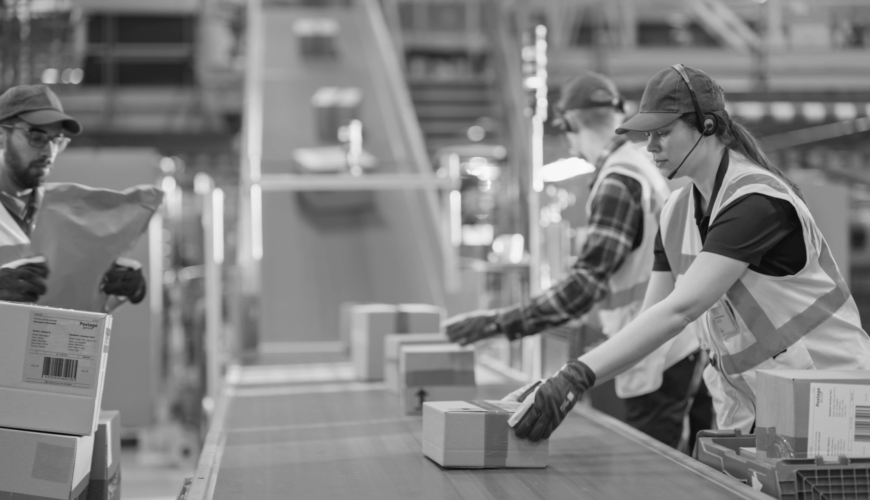A recent jobs report reveals warehouse labor availability in the United States. While immediate disruptions are minimal, the long-term outlook is shaky. The U.S. labor market continues to evolve amid shifting economic conditions, policy changes, and demographic transformations. The latest U.S. jobs report, released in early June 2025, reveals several key developments that are poised to influence labor availability in key sectors—including warehousing and logistics.
One particularly notable trend in the report is the decline in immigration, particularly at the southern border. Despite this decrease, deportation rates have remained relatively stable, meaning the current labor force, including warehouse workers, has not yet seen a sharp contraction. However, the drop in new arrivals raises concerns about the future availability of warehouse labor, a sector heavily reliant on immigrant workers to fill physically demanding, repetitive, and often lower-paying roles.
As the balance of labor supply and demand shifts, companies are increasingly turning to automation and smart technologies to meet operational needs. This article explores the current state of warehouse labor, the implications of changing immigration patterns, and how the jobs report may accelerate the push toward automation in supply chain operations.
Current State of Warehouse Labor
Labor Demand and Warehousing Growth
Warehousing has emerged as one of the fastest-growing employment sectors over the past decade, driven largely by the meteoric rise of e-commerce. Major retailers, third-party logistics providers, and regional distribution hubs have all expanded their footprints, creating sustained demand for warehouse labor.
Warehouse jobs are characterized by their physically intensive nature—manual picking, packing, sorting, and loading tasks dominate daily operations. These roles often have high turnover, and employers traditionally rely on a deep bench of available labor, including immigrant workers, to fill gaps rapidly.
Despite broader economic uncertainties in other sectors, warehousing remains resilient. However, that resilience is contingent upon continued access to a large, low-cost, and flexible workforce.
Immigration and Its Role in the Warehouse Workforce
Historically, a significant portion of the warehouse workforce in the U.S. has been comprised of immigrants—both documented and undocumented. These individuals often take on roles that are less appealing to native-born workers due to the physical demands and comparatively low wages.
The 2025 jobs report shows that while deportation numbers have remained flat, the number of new immigrants entering the country has fallen. This is especially true at the southern border, which has traditionally served as a key pipeline for new labor across agriculture, construction, and logistics sectors.
Though the current pool of warehouse workers has not diminished significantly yet, the decline in immigration raises a red flag. Without replenishment, the existing labor force may age out or transition to other sectors, creating a shortfall that could be difficult to replace quickly.
The Growing Labor Challenge
Turnover and Retention Issues
Warehousing is an industry plagued by high turnover. Annual turnover rates can exceed 40% in some facilities. Factors contributing to this include repetitive stress injuries, lack of career progression, and relatively low pay.
The drop in immigration exacerbates the challenge. With fewer new workers entering the system, employers may find it increasingly difficult to backfill positions. This will likely drive wages upward over time and force employers to reevaluate how they attract and retain talent.
Regional Disparities
Some regions of the U.S. are more dependent on immigrant labor than others. In border states and urban logistics hubs, even a modest drop in immigration can create acute labor shortages. Employers in these areas may begin to feel pressure sooner than those in regions where warehouse labor is more diversified or supplemented by other population segments.
This uneven impact could lead to regional disparities in warehouse efficiency, shipping times, and labor costs—potentially affecting broader supply chain dynamics.
Strategic Business Responses
Labor Substitution Strategies
In the face of tightening labor availability, companies are evaluating ways to optimize existing personnel. Some have begun offering incentives such as signing bonuses, tuition reimbursement, and flexible shifts to attract and retain workers. Others are cross-training employees to handle multiple functions within a warehouse to increase labor efficiency.
These measures, however, have limits. There’s only so much that can be done with a shrinking pool of workers. At a certain point, operational capacity becomes constrained, and further productivity gains become difficult without altering the underlying operating model.
The Case for Automation
This is where automation becomes not just an efficiency play—but a necessity. Many businesses are now accelerating their investments in warehouse automation as a hedge against labor volatility.
Technologies such as autonomous mobile robots (AMRs), collaborative robots (cobots), and automated storage and retrieval systems (AS/RS) are increasingly being viewed as essential to maintaining throughput. These systems allow warehouses to operate with fewer human workers while still meeting customer demand for speed and accuracy.
Automation also offers consistency. Machines don’t call in sick, don’t quit, and don’t require ongoing wage negotiations. This predictability becomes incredibly valuable in a labor market that appears increasingly unstable.
Automation Adoption—The Inflection Point
Key Technologies in Use
Over the past five years, a surge in automation implementation has reshaped the warehousing landscape. The current technological ecosystem includes:
- Autonomous Mobile Robots (AMRs): These robots can navigate warehouse floors, transporting goods between stations or storage areas. They’re often used to replace manual pickers.
- Automated Conveyor Systems: These systems streamline movement of goods along defined routes, reducing the need for human transportation labor.
- AI-Powered Inventory Management: These systems use predictive analytics to track inventory levels, forecast demand, and trigger restocking autonomously.
- Collaborative Robots (Cobots): Designed to work alongside humans, cobots assist with tasks like picking or packing without full system overhaul.
The cost of these technologies has decreased, while their efficiency has improved. Return on investment (ROI) timelines have shortened, making the financial case for automation more compelling.
Barriers to Automation
Despite the clear benefits, there are challenges. Smaller operators may lack the upfront capital to invest in automation. Additionally, implementing automated systems requires specialized skills and IT infrastructure.
Another consideration is the potential displacement of existing workers. While automation reduces dependency on labor, it can also lead to job losses if not implemented alongside retraining or upskilling programs.
However, in the current context of declining immigration and labor shortages, displacement becomes less of a concern than operational continuity. Many employers view automation not as a replacement for existing workers, but as a way to maintain output in the face of diminishing labor availability.
Long-Term Outlook and Industry Transformation
Warehouse of the Future
The warehouse of 2030 is expected to look very different from the warehouse of 2020. Labor-heavy operations will be replaced by smart systems that blend human oversight with machine precision.
Facilities will be built with automation in mind—featuring modular designs, sensor-rich environments, and digital control towers. Data will play a central role in decision-making, with real-time analytics guiding everything from staffing to delivery schedules.
The jobs that remain will likely require higher skill levels, focusing on system maintenance, robotics programming, and logistics coordination. This shift will require a corresponding change in workforce training and education.
Policy Implications
As immigration remains a politically sensitive issue, businesses may need to operate under prolonged uncertainty. Without a clear policy shift that increases the labor pipeline, warehouse operators will have to rely increasingly on technology.
Policymakers may need to reconsider workforce development initiatives and immigration reform to address labor imbalances. Grants or incentives for automation investment may also become more common, particularly for small and mid-sized businesses.
Conclusion
The 2025 jobs report highlights a critical juncture for warehouse labor availability in the United States. While immediate disruptions are minimal, the long-term outlook is more precarious due to declining immigration and persistently high turnover. This presents a pressing challenge for the warehousing industry, which relies heavily on a steady stream of labor to meet demand.
As a result, companies are increasingly turning to automation—not just as a cost-saving measure, but as a fundamental strategy to maintain resilience in uncertain times. The current labor market dynamics are poised to accelerate the evolution of the modern warehouse, with automation at its core.
Over the next decade, businesses that successfully integrate automation into their supply chain operations will likely emerge as the most agile, scalable, and competitive players. The transition may not be easy, but it appears inevitable.


